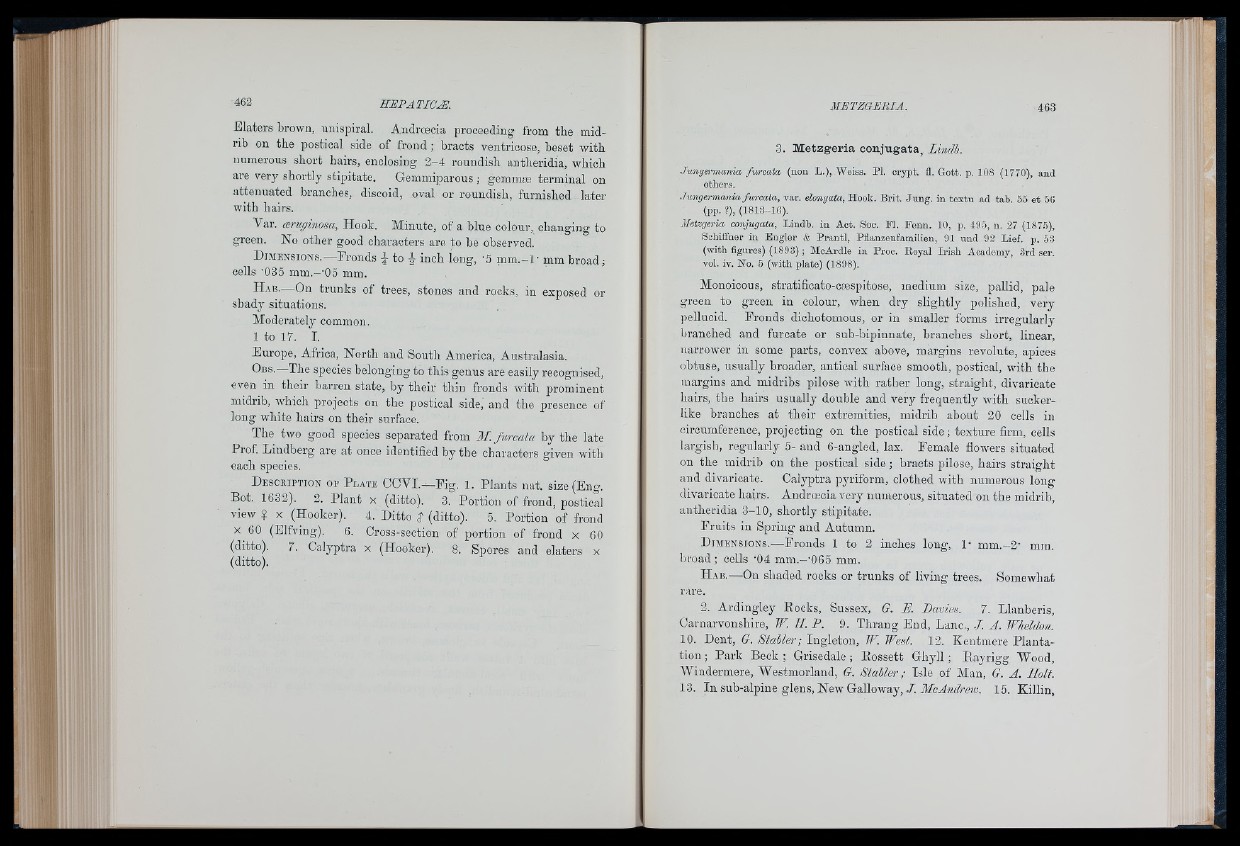
Elaters brown, unispiral. Androecia proceeding from the midrib
on the postical side of frond ; braots ventricose, beset with
numerous short hairs, enclosing 2-4 roundish antheridia, which
are very shortly stipitate. Gemmiparous ; gernmæ terminal on
attenuated branohes, discoid, oval or roundish, furnished later
with hairs.
Var. oeruginosa, Hook. Minute, of a bine colour, changing to
green. No other good characters are to be observed.
D imensions .— Fronds g to J inch long, A m m .-l' mm broad;
cells '035 mm.-'05 mm.
H ab.— On trunks of trees, stones and rooks, in exposed or
shadj' situations.
Moderately common.
1 to 17. I.
Europe, Africa, North and South America, Australasia.
Ob s .—The species belonging to this genus are easily recognised,
even in their barren state, by their thin fronds with prominent
midrib, which projects on the postical side, and the presence of
long white hairs on their surface.
The two good species separated from M. fureata by the late
Prof. xjindberg are at once identified by the charaoters given with
each species.
D escription oe P late CCVI.—Pig. 1. Plants nat. size (Eng.
Bot. 1632). 2. Plant x (ditto). 3. Portion of frond, postical
view ? X (Hooker). 4. Ditto t (ditto). 5. Portion of frond
X 60 (Elfving), 6. Cross-section of portion of frond x 60
(ditto). 7. Calyptra x (Hooker). 8. Spores and elaters x
(ditto).
3. Metzgeria oonjugata, Lindh.
.hmgermania fu rea ta (non L.), Weiss. PI. crypt, fi. Gott. p. 108 (1770), and
others.
.Jungermania fv/reata, var. elongata, Hook. Brit. Ju n g , in te x tu ad tab. 55 e t 56
(pp. ?), (1818 -16).
Metzgeria conjugata, Lindb. in Act. Soc. Fl. Penn. 10, p. 495, n. 27 (1875),
Sohiffner in Bugler & P ran tl, Pflanzenfamilien, 91 und 92 Lief. p. 58
(with figures) (1898) ; McArdle in Proc. Royal Irish Academy, 3rd ser.
vol. iv. No. 5 (with plate) (1898).
Monoicous, stratificato-oæspitose, medium size, pallid, pale
green to green in colour, when dry slightly polished, very
pellucid. Fronds dichotomous, or in smaller forms irregularly
branohed and furcate or sub-bipinnate, branohes short, linear,
narrower in some parts, convex above, margins revolute, apices
obtuse, usually broader, antioal surface smooth, postical, with the
margins and midribs pilose with rather long, straight, divaricate
hairs, the hairs usually double and very frequently with suckerlike
branohes at their extremities, midrib about 20 cells in
circumference, projecting on the postical side ; texture firm, cells
largish, regularly 5- and 6-angled, lax. Female flowers situated
on the midrib on the postical side ; braots pilose, hairs straight
and divaricate. Calyptra pyriform, clothed with numerous long
divaricate hairs. Androecia very numerous, situated on the midrib,
antheridia 3 -1 0 , shortly stipitate.
Fruits in Spring and Autumn.
D im e n s i o n s .—Fronds 1 to 2 inches long, 1' mm.-2' mra.
broad ; cells '04 min.-'0 6 5 mm.
H ab.—On shaded rooks or trunks of living trees. Somewhat
rare.
2. Ardingley Rocks, Sussex, G. B. Davies. 7. Llanberis,
Carnarvonshire, W. U. P. 9. Thrang End, Lano., J. A. IVheldou.
10. Dent, G. Stahler; Ingleton, W. West. 12. Kentmere Plantation
; Park Beck ; Grisedale ; Eossett Ghyll ; Rayrigg Wood,
Windermere, Westmorland, G. Stahler ; Isle of Man, G. A. Holt.
13. In sub-alpine glens. New Galloway,/ . 15. Killin,